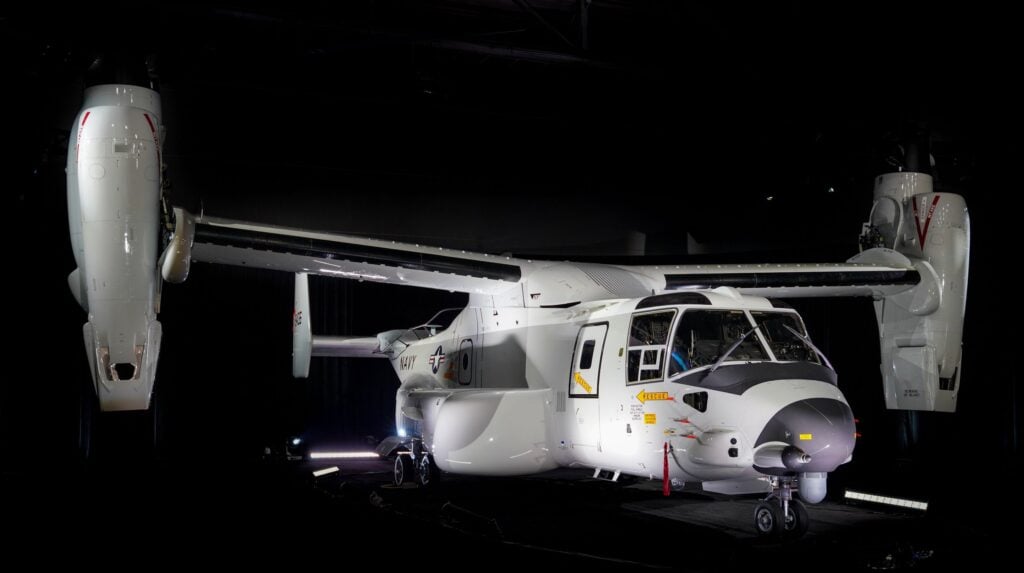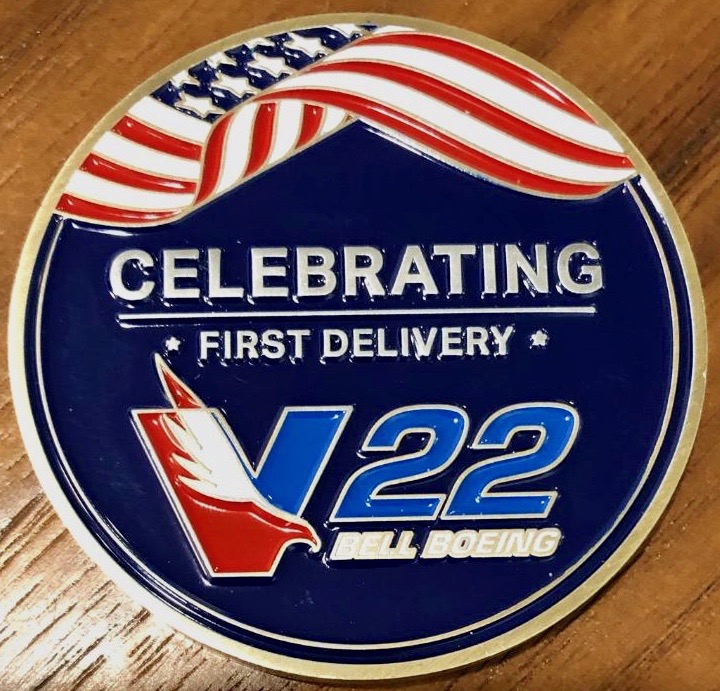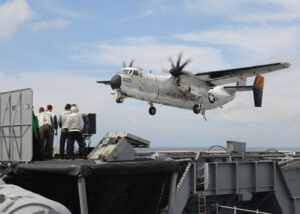
The first CMV-22B aircraft was delivered Friday to the Navy, where it will replace the C2A Greyhound, the venerable tail-hook aircraft that has flown on and off aircraft carriers since 1966.
A second Osprey arrived at Pax River the week before for the final round of testing. The fleet of Navy Ospreys should be operational within six years from contract to delivery carrying out a much wider array of roles than the old Greyhounds executed. They’ll be flying VIPs and crew back and forth, as do the venerable CODs, but they will also do search and rescue and support for Naval Special Warfare.

CMV-22B challenge coin
This is just the beginning. In a visit to San Diego the week before the ceremony, I sat down with Vice Admiral Miller, the Navy’s Air Boss, to discuss naval aviation’s future. We will publish that full interview soon, but the he highlighted a significant shift from a focus on the integrated air wing to what we can call the integrateable air wing.
The US Navy over the next decade will reshape its carrier air wing with a number of new platforms. If one lists the initial operating capabilities of each of these new platforms, and looks at their introduction sequentially, the air wing of the future would be viewed in additive terms – what has been added and what has been subtracted and the sum of these activities would be the carrier air wing of the future. But such an analysis would miss the underlying transformation under way. In effect, what is underway is a shift from integrating the air wing around relatively modest and sequential modernization efforts for core platforms to one in which new assets enter the force and create a swirl of transformational opportunities. How might we take this new asset and expand the reach and effectiveness of the carrier air group? How might it empower maritime, air and ground forces as we shape a more effective integrateable force?
But such an analysis would miss the underlying transformation under way. In effect, what is underway is a shift from integrating the air wing around relatively modest and sequential modernization efforts for core platforms to one in which new assets enter the force and create a swirl of transformational opportunities. How might we take this new asset and expand the reach and effectiveness of the carrier air group? How might it empower maritime, air and ground forces as we shape a more effective integrateable force?
Take the replacement of the C-2 with the CMV-22. For Miller, the initial task is to get the Osprey aboard the carrier and integrated with the rest of the air wing. He is looking for the first five-year period in operating the CMV-22 for the Navy to think through the role of the Osprey as a transformative force, rather than simply as a new member of the carrier air wing.

C-2 Greyhound
The aircraft differs from the Marine Corps and Air Force versions, boasting an enhanced fuel capacity which required wing modifications to deal with the greater weight. There is another key aspect. The CMV-22, unlike the C-2, can carry an F-35C engine onboard a carrier. In 2015, I was onboard the USS Wasp when an Osprey brought an engine onboard the ship to prove the capability; The Navy signed its first contract for the CMV-22 program that same year.
An F-35B pilot is now head of the Osprey program at Pax River. Col. Matthew “Squirt” Kelly told me in an interview last fall about the impact of broadening the plane’s set of users around the world:
“There is no other air platform that has the breadth of aircraft laydown across the world than does the V-22. And now that breadth is expanding with the inclusion of the carrier fleet and the Japanese. We currently have a sustainment system which works but we need to make it better in terms of supporting global operations. With the US Navy onboard to operate the Osprey as well, we will see greater momentum to improve the supply chain.”
Air Force picks Anduril, General Atomics for next round of CCA work
The two vendors emerged successful from an original pool of five and are expected to carry their drone designs through a prototyping phase that will build and test aircraft.


























